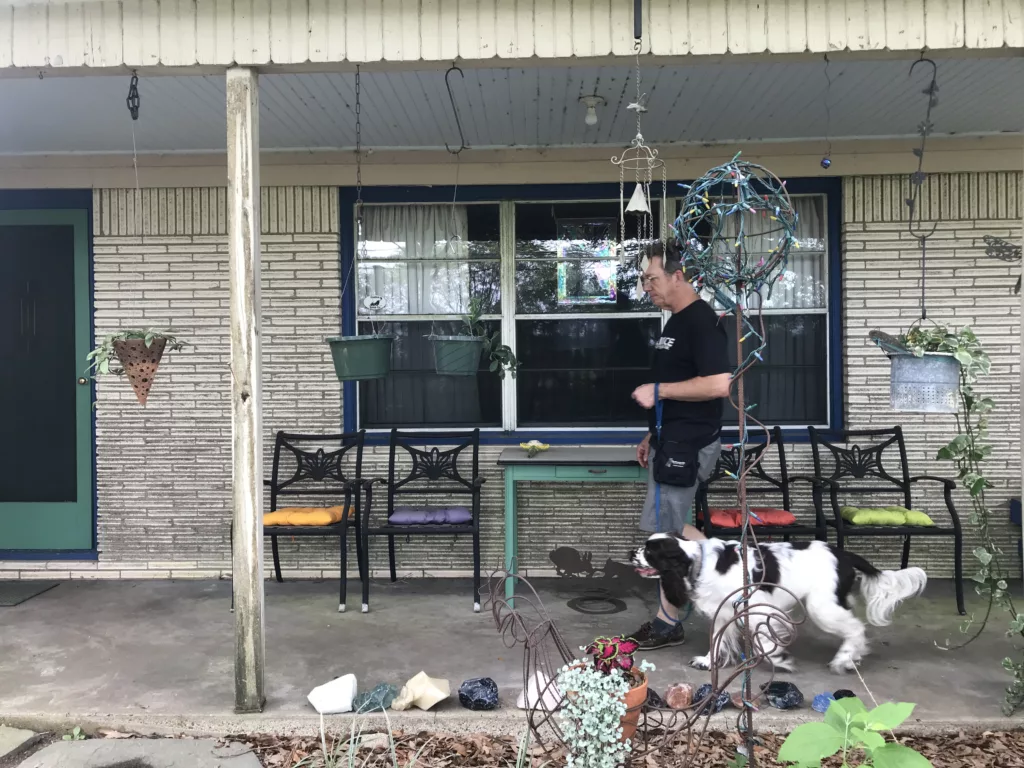Why Positive Leash Training is More Effective and Humane
In my classes, students learn leash handling skills for themselves and how to teach their dogs (and cats!) using positive reinforcement. More importantly, they learn to teach their pets what they want them to do before they ask them to do it in a highly stimulating situation. Take a look at one of my blog posts on leash training here.

One of my students pointed out an Instagram video of a trainer showing how to take a dog out to walk “up and down the driveway” and allow him to make whatever choices he will as a way of teaching leash skills. When the dog pulls against the leash, the trainer resists by pulling hard on her end, changes direction, and drags the dog along for a few steps until he begins to walk with her. Because my student is learning how to break up leash-walking into tiny pieces, reinforcing with treats as his cat learns how she can keep the leash loose, he asked why this trainer was using this very different process in which her dog was pulling hard on the leash.
While the Instagram dog is likely to learn to walk with the trainer on a loose leash in the end, the process is not as friendly, “humane” if you like, as teaching a new set of behaviors with positive reinforcement. This dog was a big one, so it’s not likely any strong pain or long-term physical damage was being done as the trainer pulled on his neck, although the topic of vertebral misalignment could be discussed.
The First Pitfall: Decreased Experimentation
The dog did not have a chance to learn what he could do to make the leash pressure stop before being subjected to the plethora of stimuli out in the world accompanied by strong, extended leash pressure. The only feedback he got was the trainer pulling hard on his leash as he pulled in the other direction, and finally a little relief when the leash loosened. His choices were limited, as was his control over his behavioral options. It is likely the dog’s long-term ability to seek solutions to problems, to explore how his behavior could affect outcomes, was being decreased. Here’s how.
The process the Instagram trainer was using is commonly known as Negative Reinforcement. That means the wanted behavior is reinforced – strengthened or increased in some way – by removing something that the dog doesn’t like once he performs the correct behavior. Let’s take a closer look, though.
The problem is that thing the dog doesn’t like, that aversive. The leash tightens whenever the dog smells, sees, or hears something interesting and moves toward it OR stops moving so he can investigate further, while the trainer continues walking. The leash might tighten simply because the dog doesn’t know that the trainer wants him to walk next to her on a loose leash, so he wanders willy-nilly in this environment that is rife with smells, sounds, and visually stimulating distractions.
An aversive is something the animal dislikes or that reduces his inclination to continue doing what he’s doing. As the trainer in question is trying to teach this dog to walk with her, the aversive pressure on his neck occurs as a result of any and all events, stimuli, and behaviors that occur just prior to it, in an Operant Conditioning paradigm. She’s creating a teaching situation in which whatever sparked the dog’s interest (think squirrels, bunnies, the smell of an interesting pile of poop, the sound of a barking dog) or the dog’s behavior of stopping his forward movement or moving away from the trainer result in leash pressure on the dog’s neck as she pulls hard in the opposite direction.
The aversive is also associated, in a Pavlovian or Classical Conditioning sense, with all of these stimuli and behaviors. That may be quite a long list of things: the interesting thing the dog stopped or pulled toward to investigate, the environment the incident occurred in, the trainer herself, the leash and collar he’s wearing, and literally everything that is in the picture at the time.
In addition, the “interesting thing” and environment may be different next time, but the trainer will respond in exactly the same way; she repeatedly pulled back on the leash during the short Instagram video, every time the leash tightened. She’s likely to be lengthening the list of things the aversive is associated with each time. Imagine if the dog is interested in a bird, squirrel, or human pedestrian one time, and another dog the next time.
If the leash tightens as a result of the dog simply wandering out of range by accident, because he doesn’t know what the trainer wants him to do, the list still grows because anything in the environment could be associated: a nearby fire hydrant or park bench, a car driving by, and more. All these stimuli become connected to the discomfort of pressure on his neck with the list growing in each environment and event. When you understand how animals learn, you can use the fine details of the environment to enhance your training; when you don’t understand behavior science, the details can come back to bite you.
The reinforcement that occurs when the pulling stops is the dog feeling the leash loosening as the pressure on his neck stops; the removal of the aversive is satisfying, a relief. It follows the pressure, which is likely applied for a different length of time during each event. The dog is probably building up tolerance for the pressure on his neck so that more pressure is required over time to make him uncomfortable enough to allow himself to be dragged and to move toward the pressure to try to make it stop. If he had been a small dog, there’s a chance of real injury.
One major pitfall of negative reinforcement is that you have to apply the negative so you can take it away to implement the reinforcement. The dog’s choices of behavior are likely to follow a pattern of trying to avoid the aversive rather than creatively offering behaviors to see which ones get him reinforcement that he likes, as dogs are taught to do in positive reinforcement training.
For a dog new to leash training, the fallout in terms of negative associations, frustration, and not having very much fun is real. The dog is not being allowed to explore possibilities and figure out how to get good things to happen; he’s simply tolerating the discomfort and then accidentally escaping it when his feet catch up to the dragging on his head as he gets closer to the trainer.
In the comments following the video, the trainer said that she sees lots of dogs trained with positive reinforcement that don’t have good leash skills so the “little bit of negative reinforcement finishes the job.” That’s just silly. She clearly doesn’t know how to skillfully apply positive reinforcement training to get the behaviors she wants. The resources for learning are out there for anyone to access, and one who is calling oneself a trainer should be pursuing further education. One trainer’s ignorance does not supply the logic for blaming the scientifically validated training procedure that simply implements the way animals naturally learn. Poorly trained, or incompletely trained dogs are everywhere, and they have been produced by inadequate trainers using various techniques. Besides, in the video, the trainer is clearly talking about how to start a dog new to leash training by using negative reinforcement, not “finishing the job.”
The Second Pitfall: Avoidance, Not Feedback
For a moment, to further illustrate the point, consider how shock collars work as training tools. When trainers use shock collars, a.k.a. e-collars, they typically “buzz” (warn) or “burn” the dog when he does any of a long list of unwanted behaviors. When he does the one correct behavior the trainer is looking for, he gets nothing. Compared to a shock,“nothing” is the best possible outcome.
Disregarding the potential for misuse by an unskilled trainer, this is what is happening for the dog during shock collar training: he typically tries different behaviors at a high rate, often frantically, getting many warnings and shocks until he accidentally does the right thing and the shocks stop. All behaviors except one earn him a shock. He gets “nothing” for performing that one behavior, which is probably a relief from the aversives, so negative reinforcement happens. The trainer builds and strengthens (reinforces) the desired behavior by taking away the painful shock(hence the descriptor, “negative”).
Training with positive reinforcement, in a nutshell, works in just the opposite way: the dog experiments with different behaviors, not frantically but thoughtfully, because he has no aversive to escape. Any incorrect behaviors are ignored and the one desired behavior earns the dog a reinforcer, often a tiny, tasty treat. Imagine the difference in a dog’s attitude between these two procedures:
- Negative Reinforcement: Lots of negative consequences – almost constant, in fact – and finally one correct behavior produces a moment of relief from the bombardment of warnings and discomfort.
- Positive Reinforcement: No response from the trainer, unless the dog “gets it right” and earns a treat – and a treat happens as many times as the dog produces that correct behavior.
The Third Pitfall: Poor Design of Training Sessions
With positive reinforcement training, because trainers are educated in behavior science, they set up a training environment conducive to the dog quickly choosing the correct behavior and define the behaviors they are looking to reinforce as very small actions, responses a dog new to the behavior could easily and quickly produce. Reinforcing a very small piece of the finished behavior allows the dog to get more information about the choices he’s making. The environment could be arranged and the behavior defined in this way when training with negative reinforcement, but traditionally, it is not. If trainers follow these principles, negative reinforcement can be an effective training tool because the aversive is applied at such a low level that it may only be slightly annoying rather than constricting and uncomfortable.
It is unfortunate that arrangement of the environment and breaking behaviors down into very small components seem to only come with positive reinforcement training. Hence, the Instagram trainer with the dog outdoors in a highly stimulating environment without having prepared him with the skills he would need to navigate that environment.
The Fourth Pitfall: Punishment Before the Dog Knows How to Avoid It
When using positive reinforcement, the dog is encouraged and even rewarded for experimenting with various behaviors to find the one that unlocks the treat or other form of reinforcement that the behavior produces. With negative reinforcement, experimenting to find the right behavior is stopped – the behavioral definition of punishment is “something that decreases or stops a behavior.”
There it is: Negative reinforcement encompasses a factor of punishment. Punishment provides a consequence that inhibits or eliminates the behavior it follows, just as reinforcement provides a consequence that communicates “all systems go!” for the behavior it follows. It doesn’t matter what the aversive is – maybe it’s a shock from an e-collar, maybe it’s a leash jerk; for some animals, yelling “No” at them is an aversive; for others, yelling “No” is an invitation to bark at you or start playing.
No matter what it is, you have to apply the aversive, the thing that the animal doesn’t like or wants to avoid, in order to take it away – and therein lies the crux. Application of an aversive is punishment; punishment decreases behavior and creates negative associations with that behavior, other similar behaviors, and things in the environment. This is the fallout of negative reinforcement. Remember, not only are many specific behaviors decreased, but the tendency for the animal to deliberately and consciously try out behaviors as he attempts to solve the problem of how to get the reinforcement to happen is decreased. He learns to be very careful which behaviors he tries because many of them result in pain or discomfort. He learns that experimenting may not be a good idea, and that limits his learning potential.
Pitfalls: The Big Picture
Let’s return to the Instagram video: The trainer recommends you put your dog in a situation in which he will be highly stimulated by a variety of objects and events, with no idea of what you expect of him or what will be happening, and start teaching him a completely new behavior. It sounds a little like putting your child in a busy playground and trying to teach him math skills. You probably would not do that.
Scientifically documented positive reinforcement training has as its foundation:
- Teaching animals in settings that permit the behaviors you’re looking for
- Defining behaviors in small pieces so animals build them quickly to the finished behavior you want
- Preparing animals for what is going to happen so they have skills to make the right choices.
Which training method is more effective? Which one sounds like one you’d like to participate in? Even though you may not have been raised with positive reinforcement training, don’t discount its effectiveness or your ability to learn to use it to your and your pets’ advantage. Below are a few of the recent scientific papers that are being produced demonstrating the greater effectiveness of positive reinforcement training. Take a look.
The effects of using aversive training methods in dogs: A review (Ziv, 2017)
It is true that an inadequately skilled trainer is likely to produce a poorly trained dog, no matter what methods they use. Negative reinforcement carries with it the danger of unintended fallout, especially in terms of emotional responses. But it’s clear that positive reinforcement training, when applied properly and with adequate practice, is the most effective means of teaching an animal the behaviors you want to teach, no matter what Instagram has to say about it.
Please note that qualified, skilled trainers who are educated in science-based, positive reinforcement training post on Instagram, along with nearly everyone else in the world, and that includes me! I do not mean to disrespect Instagram in any way. I’m just pointing out one of many videos that provide you, the dog owner and consumer of dog training services, incomplete and inaccurate information about the training you want and need for your pets.


